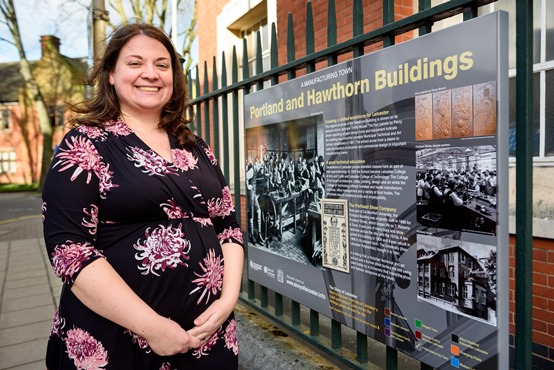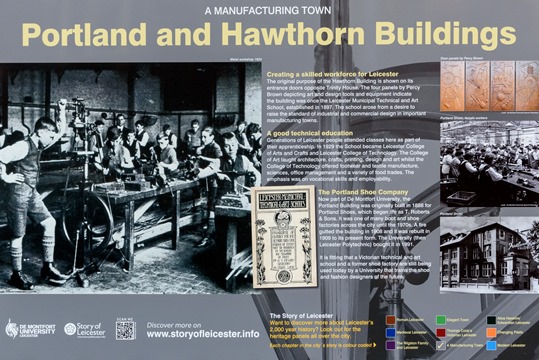Visitors can learn even more about DMU’s proud history with the fitting of a new plaque on campus as part of a city-wide tourist trail.

The story of Hawthorn and Portland buildings on the De Montfort University Leicester (DMU) campus is being celebrated with the plaque, which is attached to railings outside Hawthorn Building, across the road from Portland.
The plaque provides information about the historic significance of both buildings as part of Leicester City Council’s (LCC) Industrial Heritage trail, which invites visitors to follow plaques throughout the city.
Heritage Manager for Leicester City Council, Sally Coleman, said: “The scheme has been designed to tell the story of 2,000 years of Leicester’s history, from the Roman times to the present day.
RELATED NEWS
Be inspired. Come to our next DMU Open Day
Visit DMU’s Heritage Centre and find out about the rich history of the campus
Our stunning new Art and Design Centre opens Autumn 2016
“To date we have 67 heritage panels across the city, they are designed to help local people and visitors appreciate the rich heritage of the city and the stories behind some of the buildings they see every day.
“We decided to include both the Hawthorn and Portland buildings in the scheme because of their importance in supporting local industry, either through raising the standard of industrial and commercial design or as a former shoe factory.”
Katharine Short, DMU’s Head Archivist and Special Collections Team Manager, said: “It’s important that we acknowledge the long history of the campus site, as doing so enables us to engage with our community.

“Alongside Trinity House, the Chantry Building, Magazine Gateway, the Castle and St Mary de Castro, they [Hawthorn and Portland] are a testament to the high status this part of town had in the medieval period.
“There is a pleasing symmetry with Portland now belonging to DMU, where footwear design is still a significant subject.”
Hawthorn building is an architectural and historical gem, having been built specifically for the Leicester Municipal Technical and Art School in 1897.
DMU started as Leicester School of Art, which was founded in 1870 with classes in a disused warehouse in Pocklington’s Walk.
Leicester Technical School started classes in 1882 in the Ellis Wing of Wyggeston Boys School with the Reverend James Went as headmaster.
The School of Art and Technical School merged in 1897 as the Leicester Municipal Technical and Art School based in Hawthorn Building
Hawthorn Building was often used to train workers for the Portland building opposite, which was a world-renowned shoe factory for many years, providing shoes for royalty and British Airways air hostesses.
A year ago, the university officially opened the DMU Heritage Centre which celebrates the historic past of DMU and the surrounding buildings, some of which date back to the 11th century.
The two remaining arches of Leicester’s Church of the Annunciation – famous for being where the battle-scarred corpse of Richard III was put on public display after his death at Bosworth – form the centrepiece.
The plaque is not the first time DMU and LCC have collaborated, with a plaque placed outside Trinity House and DMU’s Heritage Centre in 2013 as part of the Richard III tour.
It’s a relationship which Sally is keen to expand upon, with the possibility of a new plaque on campus in the future.
"We have a good working relationship with staff at DMU and find that the academics and staff are as keen to celebrate Leicester’s history as ourselves," Sally added.
“In the future we are looking to add a plaque to Chantry building, as it also has a lot of interesting history behind it.”
Posted on Tuesday 9 February 2016